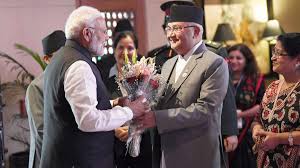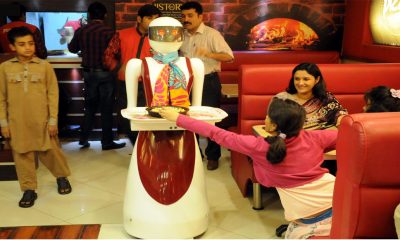Feature
A week after: It was an unforgettable Saturday

Kathmandu: “It looked like the walls of the house were converging and I would get trapped between them,” recollects Sudha Upadhaya, a week after the devastating earthquake rocked Nepal on a balmy Saturday afternoon.
Upadhyaya, 54, said she was watching television when the quake struck.
“Incidentally, the television was flashing a scroll message on how earthquakes cannot be predicted when it actually struck. Now I feel that the message was like a warning,” she recalled to a visiting media correspondent.
The housewife added that it was within seconds that her house started shaking like “they show it in the movies”, she said comparing it to “Earthquake”, a Hollywood movie made in 1974.
“I barely managed to walk to the door and just stood there holding it as tight as I could chanting all the mantras I know. I thought this was it,” she said, describing it as “the unforgettable Saturday”.
Nepal was hit by a massive earthquake measuring 7.9 on the Richter Scale on April 25, killing over 6,300 people, injuring more than 14,000 and rendering countless homeless. The death toll is expected to go up to 10,000, as per Nepal’s Prime Minister Sushil Koirala.
For nearly a week, the people of this Himalayan country were sleeping in the open in tents braving the chill and rain that accompanied the quake. “We were too afraid to go back,” a resident said, adding, “The jolt was so intense that today also we feel the earth is shaking all the time”.
A resident of Gyaneshwor, a middle-class neighbourhood with a sizable population, Sudha lives with her husband and mother-in-law, who was on the top floor of their two and a half-storied house at that time.
“I was sleeping when suddenly the bed started shaking violently. I somehow managed to hold on to a chair in the room and just sat down clasping on to it,” her mother-in-law, Damayanti, 81, told.
Rattled by the jolt, Upadhayas and their neighbours ran outside their houses and stayed there for over three hours.
Her husband, Phanindra Upadhyaya, a professor at Pokhara University, was conducting a workshop when the earthquake struck, which left nearly 78 people dead in India as well.
“It was only after an hour and a half that I could talk to her (Sudha) at home. I was conducting a workshop when the classroom started shaking and we all ran out,” Phanindra, 60, told.
He added that the family took turns sleeping in their car parked inside their garage for two nights as “it was too unsafe to even think of stepping inside the house”.
However, the family is thankful that they survived the quake but showed concern for all the quake victims in the country.
But look at that, Phanindra said while pointing to a house right across the road “the wall collapsed and a driver was crushed to death.”
“Our car was jumping two feet up and down from the ground. Never have I seen such a thing happening,” Phanindra told.
This is the saga of most of the Nepalese who have gone through this ordeal and had no such experience before. The last disaster that had struck this small country was in 1933.
Summing up however, Upadhyaya said, “No words can really describe what happened that day – a week that changed our lives forever.”
Entertainment
Meghalaya Reserves Legalized Gambling and Sports Betting for Tourists

The State Scores Extra High on Gaming-Friendly Industry Index
Meghalaya scored 92.85 out of 100 possible points in a Gaming Industry Index and proved to be India’s most gaming-friendly state following its recent profound legislation changes over the field allowing land-based and online gaming, including games of chance, under a licensing regime.
The index by the UK India Business Council (UKIBC) uses a scale of 0 to 100 to measure the level of legalisation on gambling and betting achieved by a state based on the scores over a set of seven different games – lottery, horse racing, betting on sports, poker, rummy, casino and fantasy sports
Starting from February last year, Meghalaya became the third state in India’s northeast to legalise gambling and betting after Sikkim and Nagaland. After consultations with the UKIBC, the state proceeded with the adoption of the Meghalaya Regulation of Gaming Act, 2021 and the nullification of the Meghalaya Prevention of Gambling Act, 1970. Subsequently in December, the Meghalaya Regulation of Gaming Rules, 2021 were notified and came into force.
All for the Tourists
The move to legalise and license various forms of offline and online betting and gambling in Meghalaya is aimed at boosting tourism and creating jobs, and altogether raising taxation revenues for the northeastern state. At the same time, the opportunities to bet and gamble legally will be reserved only for tourists and visitors.
“We came out with a Gaming Act and subsequently framed the Regulation of Gaming Rules, 2021. The government will accordingly issue licenses to operate games of skill and chance, both online and offline,” said James P. K. Sangma, Meghalaya State Law and Taxation Minister speaking in the capital city of Shillong. “But the legalized gambling and gaming will only be for tourists and not residents of Meghalaya,” he continued.
To be allowed to play, tourists and people visiting the state for work or business purposes will have to prove their non-resident status by presenting appropriate documents, in a process similar to a bank KYC (Know Your Customer) procedure.
Meghalaya Reaches Out to a Vast Market
With 140 millions of people in India estimated to bet regularly on sports, and a total of 370 million desi bettors around prominent sporting events, as per data from one of the latest reports by Esse N Videri, Meghalaya is set to reach out and take a piece of a vast market.
Estimates on the financial value of India’s sports betting market, combined across all types of offline channels and online sports and cricket predictions and betting platforms, speak about amounts between $130 and $150 billion (roughly between ₹9.7 and ₹11.5 lakh crore).
Andhra Pradesh, Telangana and Delhi are shown to deliver the highest number of bettors and Meghalaya can count on substantial tourists flow from their betting circles. The sports betting communities of Karnataka, Maharashtra, Uttar Pradesh and Haryana are also not to be underestimated.
Among the sports, cricket is most popular, registering 68 percent of the total bet count analyzed by Esse N Videri. Football takes second position with 11 percent of the bets, followed by betting on FIFA at 7 percent and on eCricket at 5 percent. The last position in the Top 5 of popular sports for betting in India is taken by tennis with 3 percent of the bet count.
Local Citizens will Still have Their Teer Betting
Meghalaya residents will still be permitted to participate in teer betting over arrow-shooting results. Teer is a traditional method of gambling, somewhat similar to a lottery draw, and held under the rules of the Meghalaya Regulation of the Game of Arrow Shooting and the Sale of Teer Tickets Act, 2018.
Teer includes bettors wagering on the number of arrows that reach the target which is placed about 50 meters away from a team of 20 archers positioned in a semicircle.
The archers shoot volleys of arrows at the target for ten minutes, and players place their bets choosing a number between 0 and 99 trying to guess the last two digits of the number of arrows that successfully pierce the target.
If, for example, the number of hits is 256, anyone who has bet on 56 wins an amount eight times bigger than their wager.















